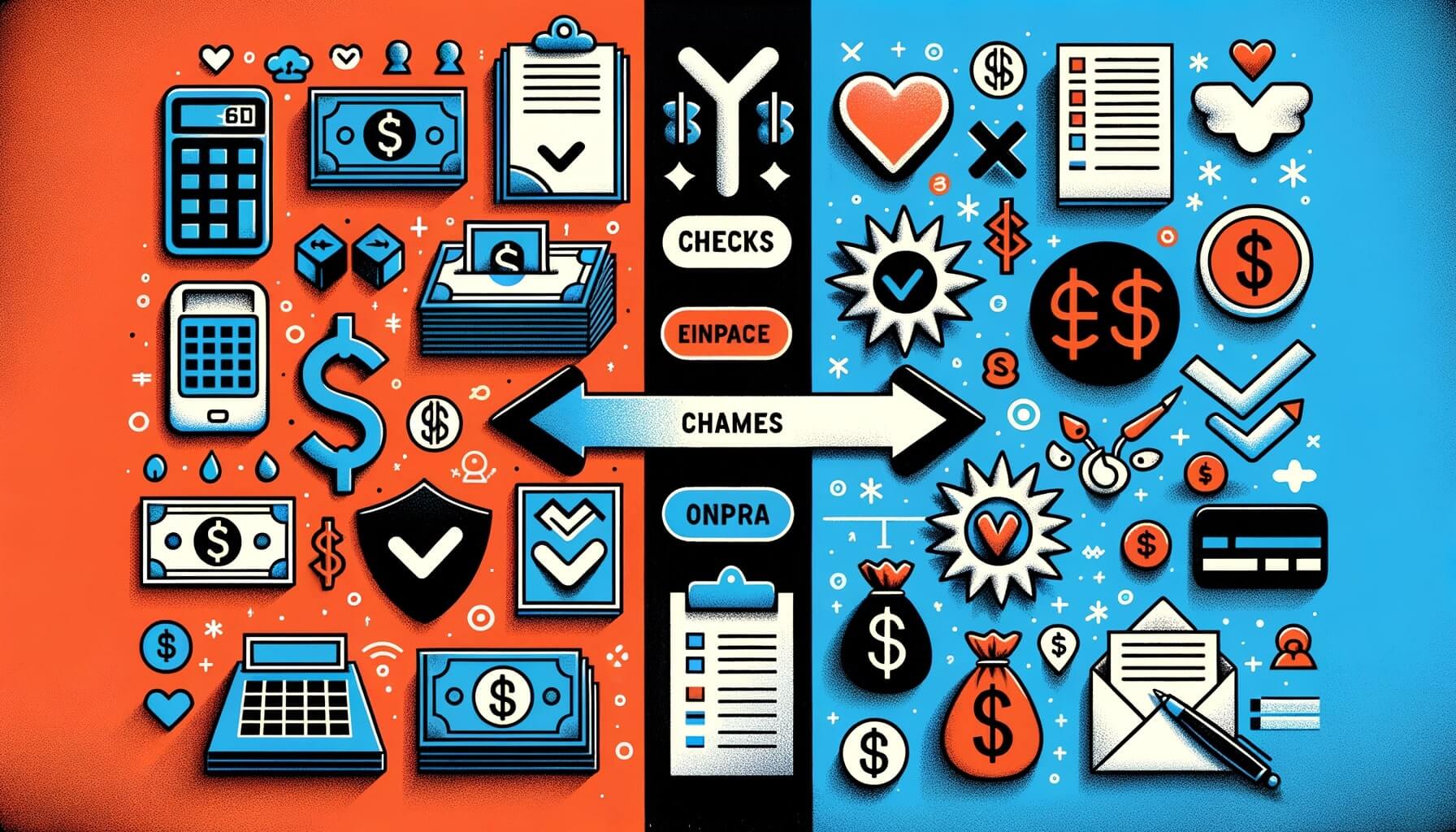
By Ava Owen April 22, 2025
In today’s digital age, businesses and consumers alike are constantly seeking faster, more efficient, and secure payment methods. One such method that has gained significant popularity is ACH (Automated Clearing House) payment processing. ACH payment processing allows for the electronic transfer of funds between bank accounts, eliminating the need for paper checks and physical cash transactions.
This article will delve into the pros and cons of ACH payment processing, exploring its benefits, drawbacks, security measures, cost-effectiveness, streamlined processes, potential risks and fraud, and its suitability for small businesses and large enterprises.
Pros of ACH Payment Processing

1. Convenience: ACH payment processing offers unparalleled convenience for both businesses and consumers. With ACH, payments can be initiated and received electronically, eliminating the need for physical checks or cash. This allows for seamless transactions, reducing the time and effort required for payment processing.
2. Cost Savings: ACH payment processing is significantly cheaper than traditional payment methods such as credit cards or wire transfers. Businesses can save on transaction fees, processing costs, and the expenses associated with printing and mailing paper checks. This cost-effectiveness makes ACH an attractive option for businesses of all sizes.
3. Faster Settlement: Unlike paper checks that require manual processing and transportation, ACH payments are settled electronically, resulting in faster fund transfers. This enables businesses to receive payments more quickly, improving cash flow and reducing the time between invoicing and receiving funds.
4. Recurring Payments: ACH payment processing is particularly beneficial for businesses that rely on recurring payments, such as subscription-based services or membership organizations. With ACH, businesses can set up automatic recurring payments, ensuring a steady and predictable cash flow.
5. Increased Security: ACH payment processing offers enhanced security measures compared to traditional payment methods. Transactions are encrypted and transmitted securely, reducing the risk of fraud or unauthorized access to sensitive financial information. Additionally, ACH payments are subject to strict regulations and monitoring by financial institutions, further safeguarding against fraudulent activities.
6. Accessibility: ACH payment processing is accessible to a wide range of businesses and consumers. It does not require specialized equipment or software, making it easy to implement and use. Additionally, ACH payments can be initiated and received through various channels, including online platforms, mobile apps, and even over the phone.
7. Environmental Sustainability: ACH payment processing contributes to environmental sustainability by reducing the reliance on paper checks. The elimination of paper-based transactions helps conserve natural resources, reduces carbon emissions associated with transportation, and minimizes waste generated from check printing and disposal.
8. Improved Cash Management: ACH payment processing provides businesses with better control and visibility over their cash flow. With electronic payments, businesses can track and reconcile transactions more efficiently, reducing the risk of errors and improving overall financial management.
9. Customer Satisfaction: ACH payment processing offers convenience and flexibility to customers, enhancing their overall experience. Customers can easily make payments from the comfort of their homes or on the go, without the hassle of writing checks or carrying cash. This convenience can lead to increased customer satisfaction and loyalty.
10. Integration with Accounting Systems: ACH payment processing can seamlessly integrate with accounting systems, simplifying the reconciliation process. Businesses can automate the recording of transactions, reducing manual data entry and potential errors.
Cons of ACH Payment Processing

1. Processing Time: While ACH payments are generally faster than traditional paper checks, they are not instantaneous. It can take a few business days for funds to be transferred between accounts, which may not be suitable for businesses or individuals requiring immediate access to funds.
2. Limited International Reach: ACH payment processing is primarily limited to domestic transactions within the United States. International payments typically require alternative methods such as wire transfers, which can be more expensive and time-consuming.
3. Potential for Insufficient Funds: ACH payments can be subject to the risk of insufficient funds in the payer’s account. If a payment is initiated without sufficient funds, it can result in fees and penalties for both the payer and the payee.
4. Lack of Real-Time Confirmation: Unlike credit card transactions that provide instant confirmation, ACH payments do not offer real-time confirmation. This can create uncertainty for businesses, especially when dealing with high-value transactions or time-sensitive payments.
5. Dependency on Banking Infrastructure: ACH payment processing relies on the banking infrastructure and systems, which can occasionally experience technical glitches or downtime. In such cases, payment processing may be delayed or disrupted, causing inconvenience for businesses and customers.
6. Limited Payment Descriptions: ACH payments have limited space for payment descriptions, which can make it challenging for businesses to provide detailed information or reference numbers for specific transactions. This can lead to confusion or difficulties in reconciling payments.
7. Compliance Requirements: ACH payment processing is subject to various compliance requirements, including adherence to the National Automated Clearing House Association (NACHA) rules and regulations. Businesses must ensure they are compliant with these rules to avoid penalties or disruptions in payment processing.
8. Potential for Fraud: While ACH payment processing offers enhanced security measures, it is not entirely immune to fraud. Cybercriminals may attempt to exploit vulnerabilities in the system or trick individuals into providing sensitive information. Businesses and consumers must remain vigilant and adopt additional security measures to mitigate the risk of fraud.
9. Limited Chargeback Protection: Unlike credit card payments that offer chargeback protection, ACH payments have limited recourse for disputes or fraudulent transactions. Once funds are transferred, it can be challenging to reverse the transaction or recover the funds in case of unauthorized or erroneous payments.
10. Complexity for Small Businesses: Implementing ACH payment processing can be more complex for small businesses with limited resources or technical expertise. It may require integration with existing systems, training employees, and ensuring compliance with regulations, which can pose challenges for smaller organizations.
Enhanced Security Measures in ACH Payment Processing

Security is a paramount concern when it comes to financial transactions, and ACH payment processing incorporates several measures to ensure the safety and integrity of electronic fund transfers.
Encryption: ACH payment processing utilizes encryption technology to protect sensitive data during transmission. Encryption converts the information into an unreadable format, making it virtually impossible for unauthorized individuals to access or decipher the data.
Secure Socket Layer (SSL) Certificates: SSL certificates are used to establish secure connections between the sender and receiver of ACH payments. These certificates verify the authenticity of the parties involved and encrypt the data exchanged, providing an additional layer of security.
Tokenization: Tokenization is a process that replaces sensitive data, such as bank account numbers or social security numbers, with unique tokens. These tokens are meaningless to anyone without the corresponding decryption key, reducing the risk of data breaches or unauthorized access to sensitive information.
Multi-Factor Authentication: ACH payment processing often incorporates multi-factor authentication, requiring users to provide multiple forms of identification to verify their identity. This can include passwords, security questions, biometric data, or one-time passcodes sent to registered devices.
Fraud Monitoring and Detection: Financial institutions and payment processors employ sophisticated fraud monitoring and detection systems to identify and prevent fraudulent activities. These systems analyze transaction patterns, detect anomalies, and flag suspicious activities for further investigation.
Regulatory Compliance: ACH payment processing is subject to strict regulations and compliance requirements set forth by organizations such as the National Automated Clearing House Association (NACHA). These regulations ensure that financial institutions and payment processors adhere to industry standards and best practices, further enhancing the security of ACH transactions.
Cost-effectiveness of ACH Payment Processing

One of the significant advantages of ACH payment processing is its cost-effectiveness compared to traditional payment methods. Let’s explore the various cost-saving aspects of ACH payment processing:
Transaction Fees: ACH payment processing typically incurs lower transaction fees compared to credit card payments or wire transfers. This can result in significant cost savings, especially for businesses that process a high volume of transactions.
Processing Costs: ACH payment processing eliminates the need for manual processing of paper checks, reducing labor costs associated with check handling, sorting, and depositing. This automation streamlines payment processes, allowing businesses to allocate resources more efficiently.
Check Printing and Mailing Expenses: With ACH payment processing, businesses can eliminate the costs associated with check printing, envelopes, postage, and mailing services. This not only saves money but also reduces the environmental impact of paper-based transactions.
Reduced Risk of Fraud: ACH payment processing incorporates enhanced security measures, reducing the risk of fraud or unauthorized transactions. By mitigating the potential financial losses associated with fraud, businesses can save money on chargebacks, investigations, and legal expenses.
Improved Cash Flow: ACH payment processing enables faster settlement of funds, improving cash flow for businesses. With quicker access to funds, businesses can optimize their working capital, reduce reliance on credit, and potentially save on interest expenses.
Streamlined Payment Processes with ACH
ACH payment processing offers streamlined payment processes that can benefit businesses and consumers in several ways:
Automation: ACH payment processing automates payment initiation and receipt, eliminating the need for manual intervention. Businesses can set up recurring payments, schedule future payments, or initiate bulk payments, reducing the administrative burden and saving time.
Integration with Accounting Systems: ACH payment processing can seamlessly integrate with accounting systems, simplifying the reconciliation process. Businesses can automate the recording of transactions, reducing manual data entry and potential errors.
Payment Reminders: ACH payment processing allows businesses to send automated payment reminders to customers, reducing the need for manual follow-ups. This can improve payment collection rates and reduce the time and effort spent on chasing overdue payments.
Electronic Invoicing: ACH payment processing can be integrated with electronic invoicing systems, enabling businesses to send invoices electronically and receive payments directly through the ACH network. This eliminates the need for paper-based invoices and manual data entry, streamlining the invoicing and payment collection process.
Real-Time Reporting: ACH payment processing provides businesses with real-time reporting and visibility into their payment transactions. This allows for better cash flow management, improved financial planning, and the ability to identify and address any discrepancies or issues promptly.
Potential Risks and Fraud in ACH Payment Processing
While ACH payment processing offers enhanced security measures, it is not entirely immune to risks and fraud. It is crucial for businesses and consumers to be aware of potential risks and take necessary precautions:
Phishing Attacks: Cybercriminals may attempt to trick individuals into providing sensitive information through phishing attacks. These attacks often involve fraudulent emails or websites that mimic legitimate financial institutions or payment processors. Businesses and consumers should exercise caution and verify the authenticity of any requests for personal or financial information.
Unauthorized Transactions: ACH payments can be subject to unauthorized transactions if an individual’s bank account information is compromised. It is essential to protect sensitive information, such as bank account numbers and login credentials, and regularly monitor account activity for any suspicious transactions.
Account Takeover: Account takeover occurs when a fraudster gains unauthorized access to an individual’s bank account and initiates fraudulent ACH payments. Businesses and consumers should use strong passwords, enable multi-factor authentication, and regularly monitor their accounts for any unauthorized activity.
Social Engineering: Social engineering involves manipulating individuals into divulging sensitive information or performing actions that benefit the fraudster. Businesses and consumers should be cautious of unsolicited phone calls, emails, or messages requesting financial information or payment initiation.
ACH Fraud: ACH fraud can occur when fraudsters initiate unauthorized ACH payments using stolen bank account information. Businesses should implement robust fraud detection systems, monitor transaction patterns, and reconcile payments regularly to identify any fraudulent activity.
ACH Payment Processing for Small Businesses
ACH payment processing can be particularly beneficial for small businesses, offering numerous advantages:
Cost Savings: ACH payment processing is cost-effective for small businesses, as it incurs lower transaction fees compared to credit card payments or wire transfers. This can result in significant cost savings, especially for businesses with limited resources.
Improved Cash Flow: ACH payment processing enables faster settlement of funds, improving cash flow for small businesses. With quicker access to funds, small businesses can better manage their working capital and meet their financial obligations.
Convenience: ACH payment processing offers convenience for small businesses, eliminating the need for manual check handling or cash transactions. Small businesses can easily initiate and receive payments electronically, reducing administrative tasks and saving time.
Recurring Payments: ACH payment processing is particularly beneficial for small businesses that rely on recurring payments, such as subscription-based services or membership organizations. With ACH, small businesses can set up automatic recurring payments, ensuring a steady and predictable cash flow.
Integration with Accounting Systems: ACH payment processing can seamlessly integrate with accounting systems used by small businesses, simplifying the reconciliation process. This automation reduces manual data entry and potential errors, improving overall financial management.
ACH Payment Processing for Large Enterprises
Large enterprises can also benefit from ACH payment processing in several ways:
Cost Reduction: ACH payment processing offers cost savings for large enterprises, especially those processing a high volume of transactions. Lower transaction fees, reduced processing costs, and the elimination of paper-based transactions can result in significant cost reductions.
Efficiency and Scalability: ACH payment processing allows large enterprises to streamline payment processes and handle a high volume of transactions efficiently. With automation and integration capabilities, large enterprises can scale their payment operations without increasing administrative overhead.
Cash Management: ACH payment processing provides large enterprises with improved cash management capabilities. Real-time reporting, better visibility into payment transactions, and automated reconciliation processes enable large enterprises to optimize their cash flow and make informed financial decisions.
Enhanced Security: ACH payment processing incorporates enhanced security measures, providing large enterprises with robust protection against fraud and unauthorized transactions. Compliance requirements and monitoring by financial institutions further enhance the security of ACH transactions.
FAQs
Q1. What is ACH payment processing?
Answer: ACH payment processing refers to the electronic transfer of funds between bank accounts using the Automated Clearing House network. It eliminates the need for paper checks and physical cash transactions, offering convenience, cost savings, and enhanced security.
Q2. How long does it take for ACH payments to settle?
Answer: ACH payments typically take a few business days to settle, depending on the banks involved and the timing of the payment initiation. While not instantaneous, ACH payments are generally faster than traditional paper checks.
Q3. Are ACH payments secure?
Answer: ACH payment processing incorporates various security measures, including encryption, SSL certificates, tokenization, and multi-factor authentication. However, businesses and consumers should remain vigilant and adopt additional security measures to mitigate the risk of fraud.
Q4. Can ACH payments be reversed?
Answer: ACH payments can be reversed in certain circumstances, such as unauthorized transactions or errors. However, the process for reversing ACH payments can be more complex compared to credit card chargebacks, and it may require cooperation between the payer, payee, and financial institutions involved.
Conclusion
ACH payment processing offers numerous benefits for businesses and consumers alike. The convenience, faster processing times, lower transaction costs, enhanced security measures, and streamlined payment processes make ACH an attractive payment option. While there are some drawbacks, such as delayed funds availability and limited international reach, the advantages outweigh the disadvantages for most businesses.
ACH payment processing is a cost-effective and efficient solution that can improve cash flow, reduce administrative costs, and enhance customer satisfaction. As technology continues to advance, ACH payment processing is likely to become even more prevalent in the payment landscape, revolutionizing the way businesses and consumers transact.